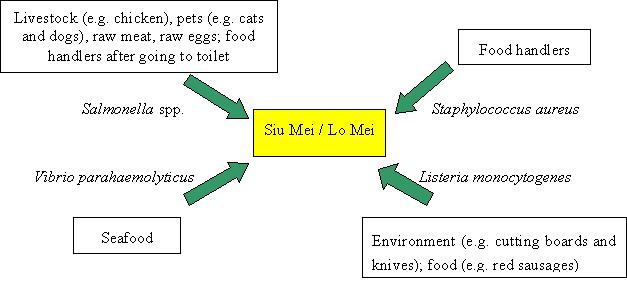Besides observing the basic hygiene practices, food handlers should know the characteristics of siu mei and lo mei and their processing / handling in order to enhance food safety of the products. The following information is prepared for food handlers to identify and control the possible hazards associated with the sale of siu mei and lo mei to prevent the occurrence of food poisoning:
- Characteristics of siu mei and lo mei and their selling process
- Pathogens related to siu mei and lo mei and their transmission pathways
- Causes of food poisoning outbreaks related to the consumption of siu mei and lo mei
Characteristics of siu mei and lo mei and their selling process
Siu mei (e.g. roasted pork) and lo mei (e.g. lo shui goose) are often cooked thoroughly (core food temperature reaches 75oC or above) to destroy the microorganisms present, therefore, from the microbiological point of view, they are safe for consumption. However, most of the siu mei and lo mei are meat or poultry which are high in protein content. This makes siu mei and lo mei conducive to the growth of pathogens.
Furthermore, characteristics of various siu mei and lo mei are different. For example, steamed plain chicken is not only higher in water activity but also lower in salt content than roasted pork, rendering it more susceptible to survival / growth of pathogens. In general, pathogens are more likely to survive / grow in food with high water activity and low salt content. As a result food handlers should pay special attention when handling these types of siu mei and lo mei.
During the manufacturing of siu mei and lo mei all the pathogens should have been destroyed by heat. However, due to the bare hand contacts afterwards (e.g. during display and chopping), the chance of microbiological contamination is increased. Traditionally, siu mei and lo mei are displayed at room temperature (in summer, room temperature often reaches 30oC or above). If they are handled improperly, pathogens will grow rapidly, and thus increase the chance of occurrence of food poisoning.
Pathogens related to siu mei and lo mei and their transmission pathways
The pathogens most commonly related to siu mei and lo mei include Salmonella spp., Staphylococcus aureus, Vibrio parahaemolyticus and Listeria monocytogenes.
Salmonella spp.
- They are widely present in faeces of humans and animals. In order to reduce the chance of transmission, food handlers should wash their hands thoroughly after going to the toilet. No raw foods should be stored / prepared and no pets should be allowed in the area where siu mei and lo mei are sold.
Staphylococcus aureus
- They are widely present in the nasal passages and throats, and on the hair and skin of humans, and are most often transmitted from food handlers to siu mei and lo mei. In order to reduce the chance of transmission, food handlers should observe good personal hygiene practices and appropriate handwashing method .
Vibrio parahaemolyticus
- They can be isolated from the marine environment and seafood. No raw seafood should be handled in the area where siu mei and lo mei are sold.
Listeria monocytogenes
- They can be isolated from the environment (e.g. cutting boards and knives, etc.), soil, faeces of humans and animals, sewage and grease. A cleaning and sanitation programme should be in place to ensure that cleaning of floors, walls, working tables and equipment, etc. are conducted in a systematic and regular manner. Besides, it should be ensured that core food temperature reaches 75oC or above when cooking or reheating food including red sausages, etc.
Transmission pathways of pathogens related to siu mei and lo mei
Causes of food poisoning outbreaks related to the consumption of siu mei and lo mei
The following are the major causes of food poisoning outbreaks related to the consumption of siu mei and lo mei. They can be categorized into two groups:
- Microbiological contamination of siu mei and lo mei
- Improper personal hygiene practices and/or infected staff (improper handwashing)
- Cross contamination (hands, cutting boards, equipment, etc.)
- Use of unreliable sources (contamination of foods during transportation to the siu mei and lo mei shop; use of non-permitted food additives during manufacturing process)
- Survival or growth of pathogens in siu mei and lo mei
- Prepare food too far in advance
- Inadequate cooking (core food temperature does not reach 75oC or above)
- Inadequate reheating (core food temperature does not reach 75oC or above)
- Prepare food in excess and improper handling of leftovers
